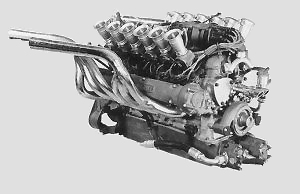 |
||
| A Collection of Maserati Engines Part II | ||
The contents of this page will enable Maserati enthusiasts and those not so aquainted with this great Marque to see and appreciate the outstanding engineering skills and ingenuity behind Maserati's legendary racing, sports car and GT history. |
| ENGINE TIPO 5000 GT Years of production: 1960-1964 V8-cyl @ 90° 4941.1 cc engine 4OHC with two valves per cylinder Bore 94mm and stroke 89mm Compression ratio 8.5:1 Power output 340bhp @ 5800 rpm Induction system by Lucas fuel injection system. |
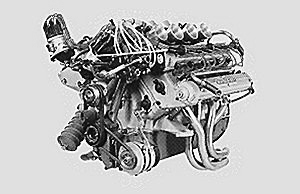 |
|
One of the greatest Gran Turismo, in the true sense of the words, was the 5000 GT. When Maserati officially (many privateers continued to race with unofficial factory support) retired from competition in 1957, they were approached by the Shah of Iran with a view to building a 'road-friendly' version of the 450S race car. Thus in 1959 was born the 5000 GT, the fastest road car in the world. The 5000 GT engine was originally fitted with four Weber 45IDM carburettors and from 1960 with the Lucas indirect fuel injection system, now standard equipment for the 3500GT. |
|
| ENGINE TIPO 6400 Years of production: 1962-1965 V8-cyl @ 90° 6458 cc engine 4OHC with two valves per cylinder Bore 110mm and stroke 85mm Compression ratio 10.6:1 Power output 580bhp @ 6000 rpm Induction system by four 48 IDM carburettors. |
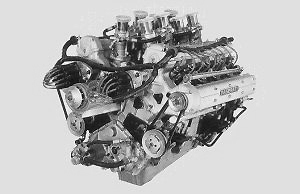 |
|
The Tipo 6400 was based on the 5-litre engine of the 450S and with
its diplacement enlarged to 5,600cc and finally to 6,400cc, this V-8 engine was adapted
for marine use to power KD 800 kg and KD 900 kg inboard racing boats. |
|
| ENGINE TIPO 8 Year of production: 1963 V12-cyl @ 60° 1493.3 cc engine 4OHC with two valves per cylinder Bore 52.2mm and stroke 52mm Compression ratio 12.0:1 Power output 200bhp @ 12000 rpm Induction system by Lucas indirect fuel injection system. |
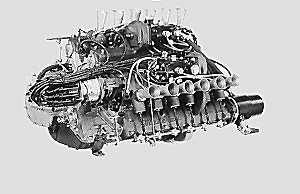 |
|
When in 1961 engine size was reduced to 1500 cc for Formula 1, Giulio Alfieri experimented with the idea of an engine being mounted in a transverse rear position. The resulting engine was designed and built in 1963 and developed in 1964 to run in the F1 World Championship reserved for the 1,5-litre single-seater. The 60° V-12 engine with transmission in unit was designed to be mounted in a transverse rear position, a really unusual and new design for that period. This V-12 engine underwent long delays in its preparation, was bench tested for the first time in 1963 and after further delays was abandoned in 1964 when for the 1966 Grand Prix season a new 3-litre formula was to be introduced. However, this Maserati technology was later adopted by Honda for its F1 car and by Lamborghini for its Miura. |
|
| ENGINE TIPO 107 Year of production: 1963-1988 V8-cyl @ 90° 4135.8 cc engine 4OHC with two valves per cylinder Bore 93.9mm and stroke 85mm Compression ratio 8.5:1 Power output 290bhp @ 5000 rpm Induction system by No 4 Weber 38 DCNL5 carburettors. |
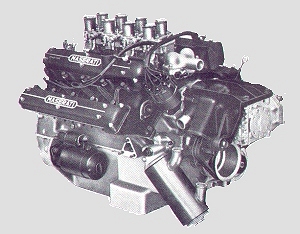 |
|
This fabulous four overhead camshaft V8 engine graced most of the great Maserati supercars of the sixties and seventies. A natural evolution of the powerful unit that powered the 450S, it was first used in the Tipo 107 'Quattroporte' and then in the Tipo 112 'Mexico', the Tipo 116 'Indy', the Tipo 117 'Bora', the 'Kyalami' and finally the 'Quattroporte III'. This engine was also manufactured as a 4709 cc unit producing 290 bhp at 5000 rpm and a 4930.6 cc unit producing 280 bhp at 5500 rpm. |
|
| ENGINE TIPO 9 Year of production: 1966 V12-cyl @ 60° 2989 cc engine DOHC with two valves per cylinder Bore 70,4mm and stroke 64mm Compression ratio 11.0:1 Power output 360bhp @ 9000 rpm Induction system by Lucas indirect fuel injection system. |
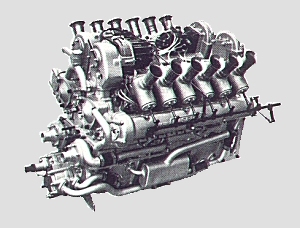 The early V12 with 12 Dell'Orto carburettors |
|
The first Maserati V-12 engine was designed in 1956 for the 350S sports car and the Tipo 250F 2T single-seater. In the 1957 season a 250F powered by the V12 made its debut at the French GP and later that year Jean Behra led the Italian GP at Monza before retiring with lubrication problems. Unfortunately Maserati retired from motor racing at the end of 1957 season and the V-12 engine was left undeveloped. Ten years later, bench tests were initiated using six Weber 38 IDM carburettors and dual ignition but after track testing at Goodwood, the carburettors were replaced by a Lucas indirect fuel injection system. This engine was adopted by the Cooper-Maserati F1 team and competed successfully winning GP of Mexico and the GP of South Africa in the 1966 and 1967 seasons, achieving second and third places in the 1966 F1 Championship with John Surtees and Jochen Rindt. During the 1967 season there appeared a new revised engine, the Tipo 10, with three valves (two intake and one exhaust) per cylinder. The Tipo 10 produced 380bhp at 9800 rpm and weighed only 171 kg but unfortunately proved to be 'too fragile' and after many retirements it was replaced mid-season by the Tipo 9 engine. |
|
| ENGINE TIPO C114 Years of production: 1970-1974 V6-cyl @ 90° 2675.1 cc engine 4OHC with two valves per cylinder Bore 87mm and stroke 75mm Compression ratio 9.0:1 Power output 188 bhp @ 6250 rpm Induction system by Bosch fuel injection system. |
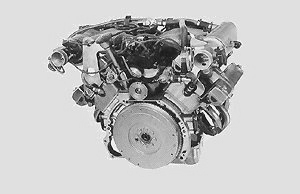 |
|
When in 1967, Citroen took control of Maserati, its main aim was an engine source for its prestigious models. This is the evolution of the original carburettor engine designed for the Citroen SM and was fitted to the second series of this fascinating model for the European market. The remarkable properties of this engine family were its compactness and its remarkable lightness: the all-alloy engine weighed no more than 140 kg and had very high specifications in terms of specific power, power to weight ratio, acceleration, rpm and the added bonus of an exciting exhaust note. |
|
| ENGINE TIPO C114.50.30 Years of production: 1972-1975 V6-cyl @ 90° 2675.1 cc engine 4OHC with two valves per cylinder Bore 91,6mm and stroke 75mm Compression ratio 7.8:1 Power output 190bhp @ 6000 rpm Induction system by Three Weber 44 DCNF carburettors. |
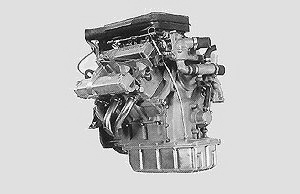 |
|
Derived from the engine designed in 1968 for the SM Citroen, this engine
was fitted to the Merak, the younger sister of the Bora. |
|
| ENGINE BITURBO Years of production: 1981-1992 V6-cyl @ 90° 1996.2 cc engine DOHC with three valves per cylinder Bore 82mm and stroke 63mm Compression ratio 9.0:1 Power output 180bhp @ 6000 rpm Induction system by No 2 IHI turbochargers with single 42DCNVH Weber carburettor (later models with fuel-injection). |
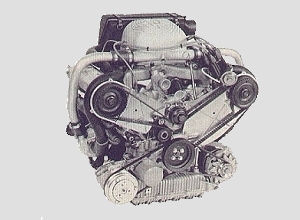 |
|
The first engine designed and built under the ownership of
Alejandro De Tomaso. The Biturbo was created to compete with the successful BMW 3 series
range and represented excellent value with its elegant looks and high specification. The
engine, despite the same V6 configuration as the C114, was of a completely new design.
Designed as a 2-litre to avoid the penal Italian 'Value Added Tax', 36% for cars over 2000 cc,
it was later produced as a 2.5 litre and a 2.8 litre for the export market. |
|
| It was updated in the persuing years as: | |
| 1983 Biturbo S | 1996.2 cc - 205bhp @ 6500 rpm |
| 1984 Biturbo 425 | 2490.9 cc - 200bhp @ 5500 rpm |
| 1984 228 | 2789.8 cc - 255bhp @ 6000 rpm |
| 1985 Biturbo S II | 1996.2 cc - 210bhp @ 6000 rpm |
| 1986 Biturbo Si | 1996.2 cc - 220bhp @ 6350 rpm |
| ENGINE 'Hi Tech' 6:36 Years of production: 1985 V6-cyl @ 90° 1996.2 cc engine 4OHC with six valves per cylinder Bore 82mm and stroke 63mm Compression ratio not known Power output 261bhp @ 7200 rpm Induction system by No 2 IHI turbochargers with single 42DCNVH Weber carburettor. |
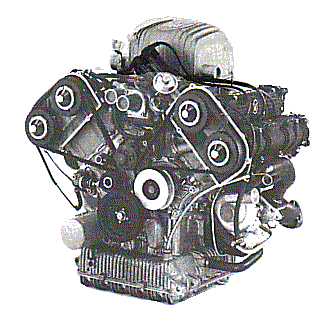 |
|
In 1985 Maserati announced this prototype V6 engine with four overhead camshafts and an amazing six valves per cylinder. It has remained a prototype! |
|
| ENGINE V6 4AC 24v Years of production: 1988-1998 V6-cyl @ 90° 1996.2 cc engine 4OHC with four valves per cylinder Bore 82mm and stroke 63mm Compression ratio 7.6:1 Power output 245bhp @ 6250 rpm Induction system by No 2 IHI turbochargers with Weber Marelli fuel injection system. |
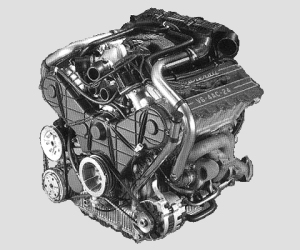 |
|
In 1988 the 'Biturbo' engine was nearing its final evolution with the
addition of new cylinder heads equipped with four valves per cylinder. New turbochargers and the Marelli Weber fuel injection system brought a new
level of smoothness and reliability and power output was increased to 245bhp. |
|
| It was updated in the persuing years as: | |
| 1990 Racing | 1996.2 cc - 285bhp @ 6500 rpm |
| 1991 Barchetta | 1996.2 cc - 315bhp @ 6250 rpm |
| 1992 Ghibli II | 1996.2 cc - 306bhp @ 6250 rpm |
| 1993 Ghibli II | 2789.8 cc - 284bhp @ 6000 rpm |
| 1995 Ghibli Cup | 1996.2 cc - 330bhp @ 7000 rpm |
| ENGINE V8 4AC 32v Years of production: 1988-1995 V8-cyl @ 90° 3217 cc engine 4OHC with four valves per cylinder Bore 80mm and stroke 80mm Compression ratio 7.5:1 Power output 326bhp @ 6000 rpm Induction system by No 2 IHI turbochargers and Weber Marelli electronic injection/ignition system. |
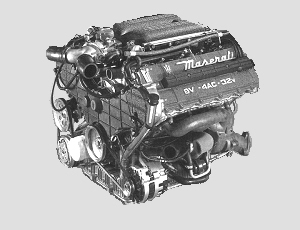 |
| ENGINE 3200GT Years of production: 1998-2001 V8-cyl @ 90° 3217 cc engine 4OHC with four valves per cylinder Bore 80mm and stroke 80mm Compression ratio 8.0:1 Power output 370bhp @ 6250 rpm Induction system by No 2 IHI turbochargers and Weber Magneti Marelli 4CM electronic injection/ignition system. |
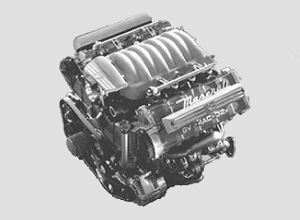 |
|
In 1989 Maserati re-entered the supercar category with the launch of the 'Shamal'. This 'Beast' utilised a new twin-turbo V8 3.2-litre engine producing some 326bhp. In 1990 this engine was chosen for the 'Chubasco' prototype but alas it never reached the production stage. 1995 saw a famous old combination revived with the arrival of the new V8 Quattroporte IV. In 1998 a new era dawned for the 'Casa del Tridente' and under Ferrari ownership the 3200 GT and the Quattroporte 'Evoluzione' were launched with power now up to 370bhp and 335bhp respectively. |
|
| ENGINE V8 4AC 32v Years of production: 2001- V8-cyl @ 90° 4244 cc engine 4OHC with four valves per cylinder Bore 92mm and stroke 80mm Compression ratio 11.1:1 Power output 390bhp @ 7000 rpm Induction system by Bosch Motronic ME7.1 electronic injection/ ignition system. |
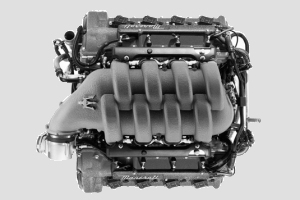 |
| ENGINE V8 4AC 32v Years of production: 2003- V8-cyl @ 90° 4244 cc engine 4OHC with four valves per cylinder Bore 92mm and stroke 80mm Compression ratio 11.1:1 Power output 400bhp @ 7000 rpm Induction system by Bosch Motronic ME7.1 electronic injection/ ignition system. |
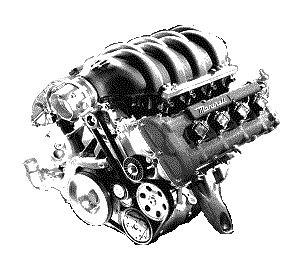 |
|
To enter Enrico's Maserati Pages CLICK HERE! Copyright: Enrico's Maserati Pages - © 2000-2005. All rights reserved. |
